


January 30th 2003 saw the official opening of Honda's new plant in Malaysia. Starting with the forming of Honda Malaysia as a true Honda subsidiary in the middle of last year followed by the official marketing of CBU models from Japan late last year, this important event heralds the dawn of a new era for Honda in Malaysia.
I had the great fortune of being invited to attend this ceremony representing Temple of VTEC Asia. Indeed TOVA has been part and parcel of the international Honda scene for the past six years so this invitation is especially satisfying as it confirms that not only do Honda recognises TOVA and indeed more importantly that Honda values their customers and fans a lot !
My invitation entitled me to media status. It was the first time I had the such an 'honour' so it was a really new and interesting experience for me. Honda had chartered private buses to ferry their invited media guests to their plant in Melaka which is situated about 160km (~100 miles) from K.L. But since I drive a VTEC Honda, readers will understand why I decided to drive there myself ! However, due to alloting insufficient time for the trip, I arrived a bit late at the plant. I also didn't know that it was a semi-public event. As a result I arrived in the midst of a mini traffic jam. There must be at least a few thousand people at the event !! I couldn't get into the alloted media gate so I had to park elsewhere and walked in through the main entrance. As a result I couldn't locate the media registration table ! Luckily my contacts at Honda Malaysia marketing helped me out. I must make special mention and convey my thanks to the Honda Malaysia (PJ) staff who ran all over the plant to get the media package for me !
The opening ceremony was graced by the attendance of both our honourable Prime Minister Dr Mahathir as well as our minister of trade and finance Rafidah Aziz. I think TOVA readers, especially those in Malaysia will be able to read about the opening ceremony in general from the regular newspapers or magazines. Again I contemplated doing similar coverages but in the end decided that it would be pointless and indeed dull to do that. Instead I decided to again do what I feel I do best - cover the new Honda plant from the viewpoint of the Honda enthusiast.
 |
 |
 |
The first thing a Honda enthusiast would be eager to see would be a photo of the new Honda plant ! Well, the plant is a rather large building and I think one single photo is definitely not going to do a very good job. Actually all the single photos I have seen so far gives a rather misleading view of the plant since the natural focal point is the central office block which has the large Honda badge. I have managed to take 3 photos at different angles and vantage points which I think gives a fair picture of the whole plant.
The 1st photo is the car assembly section of the plant with the main office building, a 2-storey structure and shown in the 2nd middle photo attached to the front of it. Most photo you'll see of the plant will actually be just this 2nd photo. The 3rd photo is taken from the right hand side of the plant building. This 3rd view shows clearly the much larger structure that is hidden if we see the building only from the vantage of the office block. Indeed the car assembly area actually extended very far behind the main office block. The famous CVJ (Constant Velocity Joint) manufacturing facility is to the far left of the whole building complex and just visible as the leftmost portion of the building in the 1st photo.
The new facility was built on an 80 acres site with an investment of 170million Malaysian ringgit (1 USD ~ 3.8 ringgit). Work actually only commenced in Aug 2001 and it took only 17 months to build this plant, Honda's 20th worldwide plant. The plant had actually started its trial run back in October last year and by December was already fully operational. The first vehicle assembled in this plant, a new CR-V, was rolled out on January 17th 2003.
For the moment, only the CR-V will be assembled in this new plant. Assembly of the current City, Civic and Accord will continue to be sub-contracted to Oriental Assemblers, Honda's current sub-contractor. For the City and Accord, I figure Honda will only move their assembly to this new plant at the most logical point which is when their respective new models are launched here in Malaysia. For the Civic, Honda traditionally implements a face-lift and mild spec changes around the mid-term of the generation's life-span. My guess is this would be the best logical time.
For the moment, plant capacity is at 20,000 units a year. This can be expanded as demand grows. Honda has invested a lot into this new plant so they will have to directly justify it via increased sales of course. The previous Malaysian Honda distributor really did leave Honda cars in a complete mess before they were kicked out. While Honda used to enjoy a dominating position in terms of sales here, stupid and plain greedy sales 'stunts' saw steadily dying sales. Situation degraded to the point that Honda dropped behind not only to Toyota but even Nissan by the turn of the new millenium. While Toyota enjoyed yearly sales volumes that measured in the tens of thousands, sales of all Honda models were averaging only ~5000 units per year. Thanks to the new CR-V, sales finally managed to hit 6000 units last year in 2002. For this year 2003, Honda has taken great efforts to establish a network of 48 dealers and 48 service-dealers nation-wide (the service-dealer is a so-called triple-S new generation of Honda dealer, one that has the three elements of Sales, Spare-parts, and Service.) With this network in place, Honda has set an ambitious sales target of 1000 units a month or 12,000 units a year, double their total sales for last year.
As part of the media group, I was 'privileged' to be able to join the guided tour of the assembly floor given by Honda Malaysia to the Prime Minister. However, most of us really could only sort of just tagged along at the back. And because I arrived a bit late, I also couldn't get the complete press-package that has a layout of the factory. As a result, while I was able to see a lot of interesting things during the tour, I couldn't get a completely clear picture of the assembly process. So for this section, I will just talk about the interesting bits that I saw. Unfortunately my rather low-end digital camera has a weak flash so the photos I took in the assembly area are dark and lacks contrast.

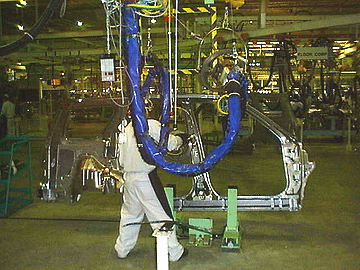
The new plant currently only does assembly of the CR-V so I re-read my CR-V press-infor. It says the new CR-V is not designed on the "body on frame" concept traditionally used on SUVs. Instead, it's a monocoque design, strengthened by extensive use of cross-members. Unfortunately I couldn't properly see the complete process where they build up the basic bodyframe of the CR-V as I was too busy making sure I kept up with the media group which was moving quite fast. I did see the unit where they were using the universal welder to build up small sections of the CR-V piece by piece. The universal welder is adopted by Honda because it does not work with a fixed jig. Rather it allows flexible mounting and positioning of the various parts and the welding machine itself can also be flexibly positioned. This allows 1 universal welder to be used to make sections for many different models. The operator I saw was building the front suspension tower mounts and also part of the floor side. The photo of this universal welder is on the left. The photo on the right has a probably more easily recognised section; the entire side frame of the CR-V.
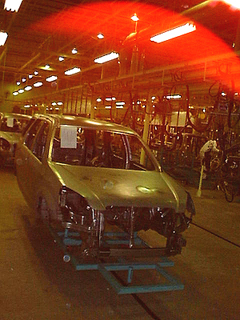

From what I have seen, various sections of the CR-V body are built up piece by piece. They are then all welded together along with the cross-members to form the complete CR-V chassis body. This chassis is placed on a trolley to carry it through the rest of the assembly line. The trollies are guided by by tracks cut into the concrete floor. The photo on the left is a completed basic CR-V chassis on its trolley. The photo on the right are the tracks I talked about, used to guide the trollies. All media members are given a red Honda cap which we were requested to put on and which is used to identify us as a media member. As a result the photos have the red discoloration which is a reflection off the cap from the flash which I forgot to take off when taking the photos.
There used to be a time where the tag "made in Japan" implies flimsy built quality or unreliable products that breaks down easily. Nowadays it's no longer that way. Japanese cars of today, especially from Japan's top two, Toyota and Honda, are reknown for their excellent build quality as well as their ability to continue to run reliably while lesser makes would have fallen at the wayside long ago. This is why I made it a special point to try to observe the Quality Control and Assurance (QA) process that Honda has implemented for the CR-V in this, their latest state-of-the-art factory.
The need for assurance that the new car we have just bought meets certain minimum standards is not something that can be trivialized. While I can't be 100% sure about their authenticiy, I have heard numerous accounts of brand new cars where nuts and bolts supposedly falls off in the middle of the road upon the first day of their delivery. Stories of brand new cars which died in the middle of a busy highway, or of cars that became an indoor swimming pool after a heavy downpour are aplenty. In this regards, Honda have generally fared extremely well in Malaysia where such stories are the very rare exception rather than the norm. Nevertheless, those Hondas that were sold by the previous distributor before 2000 did not really have a reputation for build quality either. I remember vividly the dissapointment on my friend's face when he compared his brand new locally-made 1.6l EK Civic VTi against my 3 year old used-imported EK3 5 years ago. Even with 60,000km on the clock, the EK3 was still obviously of a much higher build standard than the locally-made version. But that was the bad old days, with the bad old distributor. Today we have Honda directly running the show. In my new CR-V review, I have already stated how impressed I was with the much improved build quality that Honda Malaysia have brought to locally made cars. My Honda Malaysia contacts have told me about the extremely stringent quality control standards that is in place in this factory so I was very eager to see how they go about enforcing this standard.

Again, I only managed to observe part of the many quality control stations that Honda has in the factory. As explained, I was tagging along with the media on the guided tour given to our Prime Minister so I didn't have a chance to carefully check out the entire process, nor did I have time to linger around at those stations which were of interest to me. But even so, the quality control stations that I saw were impressive, and some even took me by some surprise as I didn't expect Honda would be so fussy as to be actually checking for such things !
On the assembly floor, after they have built up the basic body frame, they would send the whole frame for spray painting. The factory painting always has to maintain the highest possible finish quality but even so I was surprised to see that Honda actually has a person who checks the paint finish quality by hand ! This guy wears a thin glove and when a painted frame comes out of the station, I saw him meticulously running his fingers over different parts of the body frame. I can only conclude that he is checking to make sure the paint finish is up to par. I could see that he was concentrating on the edges of the window openings, the door frames, etc, areas where we as owners would focus on too if we were to be checking for top class paint finishing. The photo on the left was taken of him checking the body frame of a silver CR-V.
 | 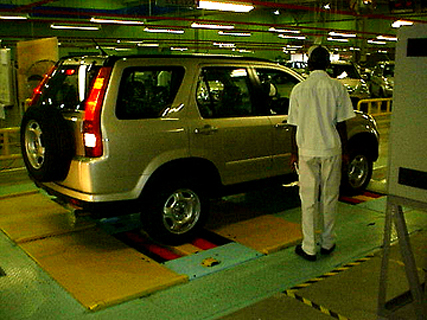 |  |
After catching up with the main entourage, I next saw a series of checking stations; a 'wheel alignment & headlight adjustion' check station; a 'speed and brake' check station; an 'under-carriage inspection' station; and then a 'engine bay' check station. I took photos of the first 3 stations, showing them side by side above. The 'speed and brake' check station was especially intriguing. Being the typical car nut, I was taking a photo of the suspension alignment check station when I heard the sound of a CR-V being revved. Immediately I thought "dyno" ! But it was not a dyno-check - I would certainly be shocked if they actually dyno-check every car for power output. The machine used for the speed check do look like a dyno machine though. The CR-V is driven into four pairs of rollers. There is a metal plate in the middle of each pair of rollers and the rollers are locked when the CR-V is driven into them. The middle plate is then lowered so that the tyres now fall in between the pair of rollers. The CR-V is now revved up to speed and then the brakes applied. When the check is completed, the middle plate is raised again, lifting the wheels up from the pair of rollers, the rollers locked and the CR-V driven away. This 'speed and brake' check station is the middle photo above which was taken when the CR-V shown has just completed its check and the middle plate has already lifted the wheels up from the pair of rollers.
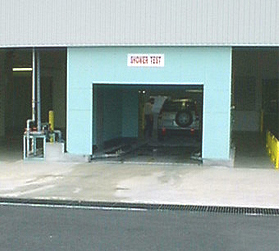
There are many more quality control stations inside the factory floor, checking for normal things like headlights, the honk, etc. But the last station I wish to talk about here is something I didn't really expect. I did not see it during the factory tour, rather I saw it while I was outside the factory, and exploring the factory compound. At the right hand side of the factory building, they have a big entrance/exit where completed CR-Vs are driven in and out for some on-the-road testing on their own internal test-track (which I will cover in the next section). What caught my eye was a bright blue construct with the words "shower test" on top. This shower test station is shown in the photo on the right. So it seems that Honda actually do check that their CR-Vs do not leak during heavy rain !
I have highlighted some of the more interesting quality control stations here. Again, I regret I didn't really have a chance to take a close look at the entire assembly and quality control process in this trip. But even then, it was enough that I was not only assured but impressed by the meticulate controls they have in place.

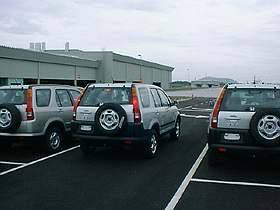
The first photos I saw of the Honda plant was late last year in some local car magazines. It was a 1 page article where the reviewer was part of a media group that were taken on the pre-opening factory tour. In it, he made a casual mention of a '2-km test track' at the plant facility. I was intrigued by this 'test track' and was frankly dissapointed that being a car magazine, they did not bother to take a closer look at this unusual facility. So upon the completion of the official ceremony, when most of the media had already left the plant, I decided to explore the factory compounds by myself for a little while. One thing about being tagged as 'media' is that the people I met when exploring the compound left me alone to roam around. Facing the front of the main office block, after taking the photos of the plant building proper, I noticed an area to the right of the office block where they park many CR-Vs, presumeably for some final check. I made my way over to the area only to discover that the test-track is just beyond.
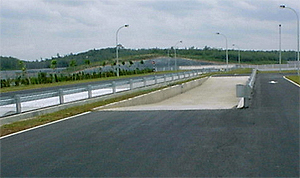
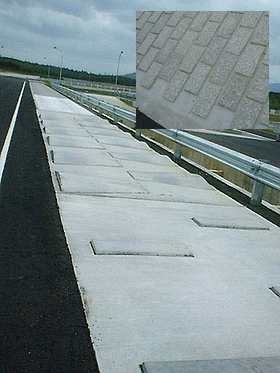
From the area where the CR-Vs were parked, the test-track entrance lies to the right (the big entrance to and from the factory is on the left). One simply gets into a CR-V, starts it up and upon exiting the parking area, makes a right turn and he or she will come up against a traffic light which marks the entrance into the test-track. Yes, the track itself is not terribly big. It's more like a two lane road that runs along 1 perimeter of the factory compound. But as I walked into the track to explore it I was surprised to find several interesting features on the track. On one part of it was a big pit, with steep ramps down into it and then up and out from it again. The ramps were quite steep, I would estimate as near if not 10% gradient. This structure is shown in the photo on the left. On another part of the track, I could see that only 1 lane was flat tarred road. The other lane was actually a simulation of various road surfaces. In the photo on the right, we can see a section of roads with alternating bumps on both sides, simulating an undulating road. This is followed by a section with rectangular concrete blocks evenly but sparsely placed, simulating a flat road but with uneven surface. And before these two sections was another section which is made up of tightly placed concrete blocks, probably simulating a non-tarred road e.g. sections of roads which are made up of Monier interlocking concrete blocks or the not terribly flat concrete roads of our national highways. This section is shown in the inset photo.
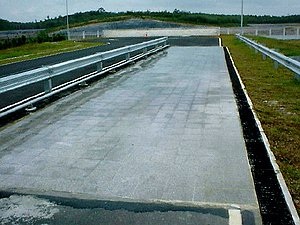
Placed a short distance away from this three sections simulating different types of road surfaces is a short section of road which was constantly wet. Shown in the photo on the right, I assume they test the CR-V's ABS here because sprinklers on one side of the road constantly spray water onto the surface, with the drainage on the right. There is a turn before this section so what must happen is the CR-V passes this section on the left lane (on the left of the armco barrier), makes a turn at the far end (which has the retaining wall) and then comes charging towards this wet section, jamming the brakes once on it so that the ABS will activate thus ensuring that it's working properly.
So as can be clearly seen, the test-track is most definitely not a simple or trivial thing. It simulates a fair amount of road conditions and situations that we can expect to encounter in normal everyday driving. So if a CR-V goes through the entire test course, we as consumers can really be assured of its quality indeed.
I think readers can see that as usual I had a lot of fun exploring the factory and its compound during this visit. It's a pity I couldn't take a close look at the entire assembly and QA process during this trip. I am now eagerly looking forward to a planned factory visit that I will be organising for my Honda club. I will definitely make sure that we have a close look at the things which are important to us then.
Finally I wish to again extend my appreciation to Honda Malaysia for the invitation to this extremely significant event. Being officially asked by Honda to have a presence at the ceremony really shows that TOVA has finally arrived and that we can look forward to a greater involvement with Honda for a very exciting future.
Wong KN
January 2003
© Temple of VTEC Asia